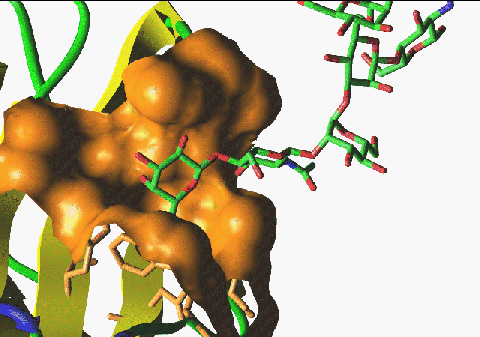Expanding Proteomics to Glycobiology:
Biocomputing Approaches Understanding the Function of Sugar



|
Pacific Symposium on Biocomputing 2002
January 3-7, 2002
Kauai Marriott Resort and Beach Club
Carbohydrates contain a higher information density than the other classes of macromolecules. In a short sequence they can potentially display a huge number of ligand structures to the binding sites of proteins in molecular recognition systems. Nevertheless, among the physiological important macromolecules, which encode biological information, carbohydrates have attracted less attention than nucleic acids or proteins both by experimental investigations as well as biocomputing approaches.
The biological functions of carbohydrates are still not completely understood. However, it is clear that glycans are fundamental to many biological processes including fertilization, immune defense, viral replications, parasitic infection, cell growth, cell-cell adhesion and inflammation. Glycosylation is one of the most abundant forms of covalent protein and lipid modification. Inspection of protein databases suggest that as many as 70% of proteins have potential N-glycosylation sites. Glycoproteins and glycolipids are major components of the outer surface of mammalian cells. They represent key structures for the interaction of cells with toxins, viruses, bacteria, antibodies and micro-organisms. The spatial structure of glycans provide the driving force for many intermolecular interactions and thus predetermine their function. Their flexibility and dynamics frequently play a key role in biological activity and must be taken into account.
The goal of this session is to bring together computational biologists, researchers, and practitioners dealing with glycorelated questions in order to present recent developments and to exchange ideas in the field of glycobioinformatics. A broad discussion which future developments are required so that glycorelated data bases and applications become indispensable tools for the daily work of the glycoscientists is intended.
Papers covering development of glycorelated data bases, their annotation and cross linking, new algorithms, techniques, and applications are invited.
| Submissions are due | 16 July 2001 |
| Decisions are announced | 20 August 2001 |
| Camera ready copy due | 24 September 2001 |
| Poster abstracts due | 5 November 2001 |
| Further general information | http://psb.stanford.edu |
| Information about this session | http://www.dkfz.de/spec/psb/ |
All papers must be submitted to russ.altman@stanford.edu in electronic format. The file formats we accept are: postscript (*.ps), adobe acrobat (*.pdf) and Microsoft Word documents (*.doc). Attached files should be named with the last name of the first author (e.g. altman.ps, altman.pdf, or altman.doc). Hardcopy submissions or unprocessed TEX or LATEX files will be rejected without review.
Each paper must be accompanied by a cover letter. The cover letter must state the following:
Submitted papers are limited to twelve (12) pages in our publication format. Please format your paper according to instructions found at ftp://ftp-smi.stanford.edu/pub/altman/psb. If figures can not be easily resised and placed precisely in the text, then it should be clear that with appropriate modifications, the total manuscript length would be within the page limit.